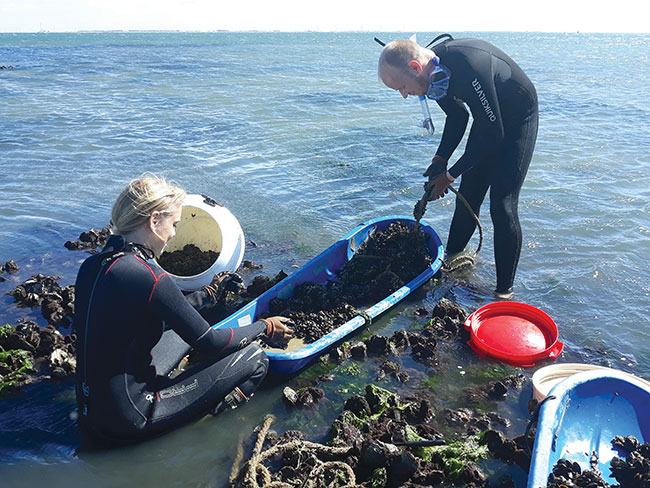
News & Views
Research
shellfish
Sustainability
Biodegradable seed mussel collector developed in the Netherlands
August 17, 2023 By Ruby Gonzalez
 Lisanne A. van den Bogaart, researcher at the Royal NetherlandsInstitute for Sea Research, with colleague, Tim Grandjean. Photo: Lisanne A. van den Bogaart
Lisanne A. van den Bogaart, researcher at the Royal NetherlandsInstitute for Sea Research, with colleague, Tim Grandjean. Photo: Lisanne A. van den Bogaart Collaboration among the Royal Netherlands Institute for Sea Research (NIOZ), Wageningen Marine Research and machine factory, Bakker BV, all located in the Netherlands, has developed the BioShell-SMC, a biodegradable seed mussel collector (SMC) used for on-bottom mussel cultivation.
It ticks all the boxes in terms of sustainability and conservation. “As a biodegradable seed mussel collector, the BioShell-SMC could potentially be relevant during this time of increased focus on sustainability and conservation. The biodegradable materials, of which the Bio-Shell has been made of, break down naturally over time, reducing the potential for long-term environmental impact,” Lisanne A. van den Bogaart, researcher at the NIOZ, told Hatchery International.
Van den Bogaart is one of the authors of the study, “Comparing traditional vs. biodegradable seed mussel collectors (SMCs) for seed settlement, seed density, and seed growth: Effect of deployment depth and location,” published on Aquacultural Engineering.
“Traditional SMCs are made of nylon and plastic. Potential loss of parts of the system or degradation of the fibers can lead to littering of the littering of the sea. The biodegradable components of the BioShell-SMC align with the principles of sustainability and conservation by minimizing waste and reducing the accumulation of non-biodegradable materials in marine ecosystems.”
The BioShell-SMC consists of a biodegradable sock based on a compound of aliphatic polyesters, placed around a coconut-fiber carrying rope and filled with empty cockle shells.
Similar to traditional SMCs, the system can be deployed in the sea to collect drifting mussel spat in the water column.
“After a few months, the entire system can be retrieved and transported to designated bottom culture plots. The inclusion of empty cockle shells within the socks makes the BioShell-SMC particularly suitable for on-bottom placement, as it provides a suitable attachment substrate for the mussel seed. This approach offers a more controlled seeding process compared to traditional mussel collectors,” she explained.
In six out of nine locations, the Bio-Shell-SMC’s yield was comparable to the traditional collector types, which is a conventional SMC made of multi-filament synthetic fibers around a core of coated lead.
Developed for one-time use, it can be seeded as an entire system and it will break down after some time. Even with equivalent capture and cultivation results, the BioShell-SMC is not more expensive than traditional ropes, van den Bogaart said.
In large quantities, socks per metre cost €0.19 (US$0.21), with an additional €0.08 (US$0.9) for filling it with empty cockle shells, making the total cost €0.27 (US$0.30) per metre for the bio collector. Price of traditional weighted SMC with a similar underwater weight is €2.20 (US$2.43) per metre, with a lifespan of eight years. Annual depreciation cost is at €0.28 (US$0.31).
The BioShell-SMC is not commercially available. Its use is currently limited to the project and not implemented on a larger scale. “If future studies demonstrate positive results for BioShell-SMC, it has the potential to make a valuable contribution to the Dutch mussel industry,” she said.
Print this page
Advertisement
- Tanzania’s aquaculture revolution from humble beginnings
- AquaGen opens Norway’s first land-based salmon egg facility





